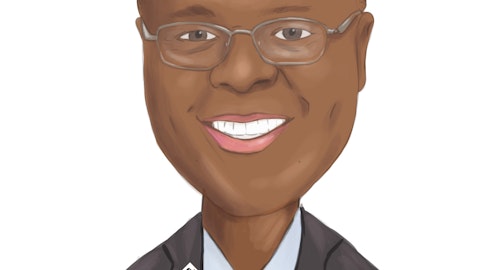Camden National Corporation (NASDAQ:CAC) Q4 2023 Earnings Call Transcript January 30, 2024
Camden National Corporation reports earnings inline with expectations. Reported EPS is $0.85 EPS, expectations were $0.85. CAC isn’t one of the 30 most popular stocks among hedge funds at the end of the third quarter (see the details here).
Operator: Good day, and welcome to Camden National Corporation’s Fourth Quarter 2023 Earnings Conference Call. My name is Cole, and I’ll be the operator for today’s call. [Operator Instructions]. Please note that this presentation contains forward-looking statements, which involve significant risks and uncertainties that may cause actual results to vary materially from those projected in forward-looking statements. Additional information concerning factors that could cause actual results to differ, supplemental earnings materials, the company’s 2022 annual report on Form 10-K and other filings from the SEC. The company does not undertake any obligation to update any forward-looking statements to reflect circumstances or events that occur after the forward-looking statements are made.
Any references in today’s presentation to non-GAAP financial measures are intended to provide meaningful insights and are reconciled with GAAP in your press release today. Today’s presenters are Simon Griffiths, President and Chief Executive Officer; and Mike Archer, Executive Vice President and Chief Financial Officer. Please note that this event is being recorded. At this time, I would like to turn this conference over to Simon Griffiths. Please go ahead.
Simon Griffiths: Good afternoon. Thank you, Cole, and welcome to Camden National Corporation’s fourth quarter 2023 earnings call. I’d like to start by introducing myself. I joined Camden National Corporation last November and took over as the President and Chief Executive Officer on January 1, and it’s an absolute pleasure and honor to join the company. Since joining, I’ve been impressed with the strength of the management team and their focus on delivering an outstanding experience for our customers. As I meet with team members and their customers, I’ve come to realize how deeply rooted Camden National is in the communities we serve, and my first months with the company have confirmed for me the pivotal role we play from large commercial customers to small business owners.
There is strong momentum for these businesses to grow, and our teammates can deliver the products and services and have the customer relationships to guide them along the way. I’m also impressed by the robust technology advancements the company has made. The team has been driving innovation and utilizing sophisticated tools to automate process, leverage data and deliver digital products to aid our customers and our team members. Earlier this morning, we reported net income of $8.5 million or $0.58 earnings per share, diluted share for the fourth quarter of 2023. This included the impact of repositioning a portion of our investment portfolio, which generated a $5 million pretax loss on the sale of securities. Excluding that impact, our adjusted non-GAAP earnings for the quarter would have been $12.4 million or $0.85 per diluted share.
The company continues to look for opportunities to adjust and optimize the balance sheet, and we expect the changes we made in 2023 will provide future benefits to our net interest margin, earnings and capital. The strength of our balance sheet continues to position us well for growth and to capitalize on market opportunities as the broader market shows signs of normalization. Our capital position remains strong and improving, highlighted by an increase in the tangible common equity ratio to 7.11% at December 31, 2023, compared to 6.47% at September 30, 2023. We continue to see solid demand for loans in the communities that we serve, and our pipeline remains steady. We’re excited by the addition of a new Director of Commercial Banking in New Hampshire with more than 22 years of banking experience.
We are already seeing positive momentum in the market, and we’ll continue to look at opportunities to strengthen our team and expand our market presence. We remain focused on full relationship banking, to strengthen customer loyalty, leveraging our robust balance sheet and actively managing new loan yields tightly given the decrease in the 10-year treasury yield over recent months. Personally, I’m invigorated by this opportunity to work with a talented and dedicated team to make an impact and build on their many successes. The swift actions taken throughout the year, including steps to stabilize our net interest margin, fortify our balance sheet and position the company for future earnings capacity to drive long-term shareholder value. These actions have positioned us well for the future and will enable us to capitalize on opportunities within our market.
Our priorities for 2024 will be to continue to manage the business with a focus on actions that prioritize long-term shareholder value while having a prudent offense mindset. We have many exciting capabilities and the delivery roadmap across our technology, digital, data analytics and AI roadmap that will continue to drive growth. The team remains laser-focused on our long-term strategic plan to drive stability, profitability and growth with strong expense discipline complemented by a talented team. I’m confident in our ability to adapt to the changing environment and economic landscape, while continuing to provide long-term shareholder value. Now I’m going to turn it over to Mike to provide some additional insights into our financial performance for the quarter.
Mike Archer: Thank you, Simon, and good afternoon, everyone. This morning, we reported net income for the fourth quarter and annual financial results for the year ended 2023. Like many others across the banking industry, our annual financial results for the year were impacted either by macroeconomic conditions and other challenges faced during the year, which included higher short-term rates in an inverted yield curve, compounded by several well-known larger regional bank failures, bringing deposits and related pricing and defer the focus across the banking industry. Our response to these marketing conditions and events included prioritizing deposits and liquidity, taking steps to help optimize our net interest margin and maintaining our strong asset quality.

We believe our capital reserve level and liquidity position us well for future growth and shareholder value creation. These priorities continue throughout the fourth quarter and remain key priorities today. Net income for the year ended December 31, 2023, was $43.4 million and diluted EPS totaled $2.97, each a decrease of 29% compared to 2022 annual financial results. Included within these results are pretax investment losses of $10.3 million as we sold lower yielding investments in the third and fourth quarters this year to reposition our balance sheet, with a focus on driving future earnings and to improve profitability, as well as a $1.8 million write-off of the Signature Bank bond. Adjusting for these items, our annual earnings on a non-GAAP basis for 2023 was $53 million and a diluted EPS on a non-GAAP basis of $3.63, decreases of 15% and 14%, respectively compared to 2022.
Net income for the fourth quarter of 2023 was $8.5 million and diluted EPS was $0.58, each a decrease of 13% compared to the third quarter this year. As noted in my earlier comments, we sold investments at a loss in the third and fourth quarters, which affected our financial results for each quarter. Adjusting for these investment losses, our earnings on a non-GAAP basis for the fourth quarter were $12.4 million and diluted EPS was $0.85, each a decrease of 11% on a linked-quarter basis. Highlights for our fourth quarter operating results included seeing signs of our net interest margin stabilizing, improving capital ratios and finishing the year with excellent asset quality. Our net interest margin for the fourth quarter was 2.40%, which was up 1 basis point from last quarter.
We continue to redeploy our investment cash flows primarily to fund loan originations in order to improve overall asset yields and anticipate we’ll continue to do so. We believe this asset remixing should help continue to stabilize net interest margin through the winter months within our markets as we generally see a level of seasonal deposit outflows and as we continue to see pressures on funding costs from deposit mix shift. The strength of our liquidity position affords us the flexibility to continue to leverage the strategy. In order to deploy all of the proceeds from the sales securities in the fourth quarter, we also reinvested a portion of the proceeds into new securities that yielded just above 6%, and that were purchased at a slight discount.
As our investment portfolio continues to produce cash flow, we expect we’ll continue to leverage this cash flow to support loan fundings. Our book and regulatory capital ratio has improved across the board in the fourth quarter, and we finished the year with a TCE ratio of 7.11%, up from 6.47% at September 30, 2023, and 6.37% at December 31, 2022. Our capital position continues to be one of our strengths and it positions us well to capitalize on market growth opportunities. Our asset quality as of December 31, 2023, remain very strong by all measures. At year-end, our nonperforming assets to total assets were 0.13%, our past due loans were 0.12% of total loans and net charge-offs for the fourth quarter were $358,000 or 0.04% of average loans on an annualized basis.
The overall health of our customer base continues to be very positive, highlighted by criticized and classified assets of 1.13% of total loans at year-end, which is up from 1.05% for the third quarter, but down from 1.67% at December 31, 2022. We continue to monitor our loan portfolio proactively to identify any early signs of stress. And to date, we’re not seeing any systemic trends or material concerns. The increase in provision expense between the third and fourth quarters was $1.1 million and contributed to the decrease in our linked quarter earnings on a GAAP and non-GAAP adjusted basis. In the third quarter, we reported negative provision expense or credit primarily driven by a decrease in loan balances of 1% during the third quarter.
Whereas in the fourth quarter, we provisioned $569,000 driven by loan growth of 1%. Like last quarter, we maintained our loan loss reserve levels of 0.90% of total loans as we take into account our overall asset quality and with the macroeconomic forecast. Noninterest income for the fourth quarter totaled $6 million and was higher than reported for the third quarter by 18%, primarily driven by a few non-core items, including mortgage banking, fair value adjustments, and a smaller loss on our sale of investment securities compared to the third quarter. Adjusting for these items, noninterest income for the fourth quarter would have been $10.6 million, which included the benefit of our annual Visa incentive bonus of $400,000 in the fourth quarter compared to $10.5 million of fee income for the third quarter.
We continue to estimate that our normal recurring noninterest income will be $9.5 million to $10 million quarterly in the near term. Noninterest expense for the fourth quarter was $27.8 million, an increase of $1.6 million or 6% on a linked-quarter basis. As anticipated, operating costs increased over the last quarter given various factors, including timing of incentive accrual true-ups, senior leader transition costs and normal seasonal costs during the winter months. Higher noninterest expense for the fourth quarter translated into a non-GAAP efficiency ratio of 63.48% for the quarter. As we look forward, we anticipate noninterest expenses will tick higher for the first quarter of 2024 and range between $28 million and $28.5 million as incentive accruals reset to target levels, and we continue to work through transition costs.
We have taken and continue to take steps to manage costs and we are focused on managing our efficiency ratio lower throughout 2024. The last item I’ll touch on is our effective tax rate. We saw our effective tax rate for 2023 decrease to 19.4% compared to 20.3% for 2022. In the fourth quarter, we participated in a renewable solar energy project. And as a result, we are currently estimating an effective tax rate for 2024 of 18.6%. This concludes our comments. We’ll now open the call up for questions.
Operator: [Operator Instructions] Our first question is from Steve Moss with Raymond James. Your line is now open.
See also Here is How Billionaire Chris Hohn’s Hedge Fund Beat the Market with 33% Gain and Light Street Capital Returned 46% in 2023: Top 15 Picks.
Q&A Session
Follow Camden National Corp (INDEXEURO:CAC)
Follow Camden National Corp (INDEXEURO:CAC)
Steve Moss: Good afternoon, and Simon, welcome aboard.
Simon Griffiths: Thanks Steve.
Steve Moss: Maybe just starting on loan growth here, just curious how you guys are feeling about the loan pipeline, especially on the commercial side these days and how loan pricing is?
Simon Griffiths: Yes, thanks for the question, Steve. I think we anticipate throughout the year, low single-digit loan growth for the first quarter. We continue to see solid resilience at the client level across our sectors. And we’re certainly obviously going to look at the interest rate environment as a key driver of expectations as we move throughout the year. But overall, I think we continue to see solid demand and continue to leverage our balance sheet to support our communities, and deepen customer relationships and I think I see a positive outlook, certainly in the — particularly as the year passes through.
Steve Moss: Okay. That’s helpful. And just maybe in terms of the Fed probably going to cut rates this year. Just curious how you guys are thinking about the impact on the margin with rate cuts? And I realize rate cuts might be a couple months out. Just how you’re thinking about the margin here, near term, given you continue to see obviously some deposit pricing pressures in the sector?
Mike Archer: Sure. I can take that one, Steve. I would say on the margin on the near term, certainly, we’re seeing — we’re at 240 right now end of the quarter. I think as we think about the next three to six months, I would say that we’re thinking about margin being flattish, plus or minus a few basis points overall. Certainly, in the first quarter, we generally have the seasonal outflows from a deposit perspective that are impactful to us. We’re also seeing some asset remix continue — excuse me, deposit remix continue. So we’re certainly focused on that. We’ve also done some things on the funding side. I’m really trying to optimize where we can to the extent that — we have some higher cost, less of a relationship, if you will, on the deposit side, really trying to find alternate funding to optimize and think that should certainly help out as well in the first quarter.
But long story short is, I think for the first half, we’ll be pretty flattish. We’re envisioning that when rate cuts do happen that we will see a benefit. We do think that it will certainly take some time to see that come through on the funding side. We want to be able to push certainly rates and deposit costs lower, but also recognizing that deposits with particularly in our market, and I’m sure others is. It’s very competitive and we’ll recognizing that. But that being said, I think in the second half, we do anticipate to see some level of margin expansion from there.
Steve Moss: Okay. Great. Appreciate that color. And just one on expenses here. I think the guide for the first quarter, Mike, you mentioned was $28 million to $28.5 million with some transition costs. Just kind of curious, does it back down a little bit from there for the rest of the year? Or should we think about maybe there’s some ongoing investments and we stay closer to a $28 million range for the upcoming quarter?
Mike Archer: Yes. I think realistically, at least as of right now, we’re probably that $28 to $28.5 million. I do think we’ll probably on a run rate basis, be closer to $28 million than normal — on the norm there, Steve. We, like I think Simon spoke to in some of his comments and same in mine is we certainly are focused on the expenses and being prudent there. And from an efficiency ratio perspective, we keep a very watchful eye on that and always have historically and we’ll continue to do so. But we certainly were trying to balance the management of expenses short term with also making sure that we’re continuing to reinvest for the long term. So we’re trying to strike that right balance.
Simon Griffiths: Yes. I’ll just add, Steve, I think that’s spot on. I think it’s that short-term focus, and we have very specific actions managing, obviously, our personal staffing levels and other incremental investments. And I’ve been really impressed with the team’s work. On automation, we’ve got some really great work on the data side and other areas that I think are allowing us to provide — identify opportunities for process improvement and efficiencies. And we just actually had our 100th process automation and that sort of made it over 1 million transactions. And just one example, Steve, of the kind of work the team is doing that I think can drive long-term productivity and efficiency in the organization. So I think that’s obviously a near-term focus, but leveraging some of that technology is an opportunity for us.
Steve Moss: Okay. Great. I appreciate all the color. Thank you very much guys.
Simon Griffiths: Thanks Steve.
Operator: Our next question is from Damon DelMonte with KBW. Your line is now open.
Damon DelMonte: Hi, good afternoon, guys. Hope everybody’s doing well, and welcome aboard, Simon. Just wanted to follow up on the commentary around the margin, Mike, I appreciate the color that you gave. Just wondering, do you anticipate doing any additional restructurings here in the early part of ’24? Or do you think those are done?




